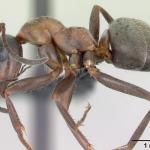This species is easily confused with Formica cunicularia, especially in the worker caste. The queen's red and black patched trunk provides a guide (see Donisthorpe, 1927, for a black and white illustration giving a good impression of this feature). Live workers appear distinctive with legs darker than the trunk and with a matt black gaster; they swarm rapidly out of the nest in large numbers to attack a disturber.
Very rare in the British Isles: all well-substantiated records are from Surrey and the Isles of Scilly; other records probably refer to F. cunicularia. Its range abroad extends across Asia to western Siberia.
Listed as Vulnerable (RDB2) in Shirt (1987) but revised to provisionally Endangered (RDB1) by Falk (1991). It is the subject of a Species Recovery Programme funded by English Nature. As in other Formica species a majority of nests produce either male or female alates only, and this must put at risk the very small populations which are known to still exist in Surrey. The other main risks are predation in conjunction with slave-making by F. sanguinea and mismanagement of the habitat. Workers of other ant species are avoided or ignored, unless near the nest, and competitive interactions may well be unimportant in the Surrey sites.
The nest habitat, as usually described, is a south facing bank with sparse vegetation on dry heathland, but some of the nests surviving now are in purple moor-grass/bristle bent (Molinia caerulea/Agrostis curtisii) grassland with grass fragments built up to make a mound in a tussock. Certainly a hotspot is needed for success and, in the laboratory, F. rufibarbis survives desiccation better than most British species.
Mainly in July.
Foraging is above ground; aphids are tended and dead arthropods are carried into the nest - many of these are found already dead, but small insects are attacked as prey.
Predation by green woodpeckers and spiders occurs, but is likely to be of minor importance.
2002


